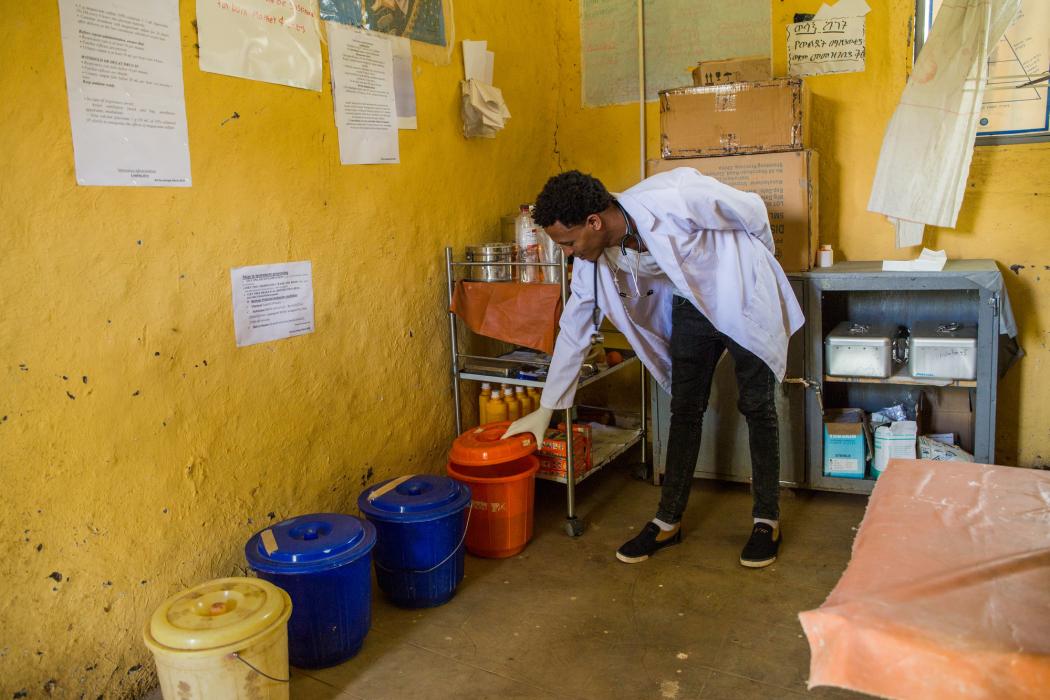Without Water, Health Workers Face An Impossible Task

Yaye Wale, 25, a clinical nurse, standing beside buckets of water used for washing medical equipment in the Delivery Room at Yiraber Health Centre, West Gojjam, Ethiopia. Photo credit: WaterAid/ Genaye Eshetu
By Danielle Zielinski, WaterAid America
Imagine you work 12-hour days in a high-stress environment. There’s no decent toilet. No soap to wash your hands. Thirsty? Sorry, you’ll have to leave and take a walk to the nearest water source.
Many of us would refuse to work under such conditions. But this is the everyday reality for far too many health workers in low- and middle-income countries.
Earlier this month, the WHO-UNICEF Joint Monitoring Programme released the first-ever global estimates for water, sanitation and hygiene (WASH) in health care facilities. They found that one in four health care facilities globally do not have clean water on site, one in five have no sanitation services, and one in six have no handwashing facilities. The numbers get even worse if you look only at health facilities in less-developed countries: 45% of health care facilities in the least developed countries have no clean water on site. In sub-Saharan Africa, only 23% of facilities have decent toilets.
While the report is a major step forward in measuring progress, it also shows there’s a lot we don’t know when it comes to tracking water, sanitation and hygiene in health care facilities. Few countries are collecting even basic data on this topic, making it hard for governments to effectively address the crisis. For example, only 18 countries had sufficient data to estimate coverage of decent toilets, and only four countries had data on how health facilities are cleaned.
We need better data to compel governments to improve conditions that health workers face day after day at work. Places like Yiraber Health Centre in rural Ethiopia, where staff have to choose daily which rooms to mop because they don’t have enough water to clean them all. Here, nurses reuse water for patients and cannot wash their hands as often as they like.
“It is hard to express it – it is a sorrowful experience working here,” says Yaye Wale, a clinical nurse at the health center. “I feel sad that, instead of healing patients, I might expose them to other diseases. Though we work in health, we are in a highly infectious environment.”
Lack of water, sanitation and hygiene in health facilities is risky both for health workers and their patients. Unhygienic conditions contributed to more than 800 health workers contracting Ebola during the 2014-2016 West Africa epidemic, resulting in more than 500 health worker deaths. Similarly, in the current outbreak in the Democratic Republic of Congo, significant numbers of new cases are being acquired within health care settings.
Overall, 15% of patients in developing countries acquire at least one infection during a hospital stay, and health-care associated infections continue to be major driver of antibiotic resistance. In addition to the implications for disease transmission, unhygienic conditions in health care facilities negatively impact health worker attendance, morale, retention and safety.
"A year back, I was hired here with two of my friends. But they couldn't handle it,” Wale said. “They said, 'How can we work on children's health without water in the health center?' and they left soon after.”
The good news is that this is a solvable problem – as WaterAid’s work in multiple countries shows. Alongside the new data, WHO and UNICEF have published a report on “Practical Steps to Achieve Universal Access to Quality Care” that captures experiences from around the world and suggests actions that governments and other stakeholders can take to address this pressing issue. These include investing in training the health workforce, establishing national standards for WASH in health care facilities, improving data collection and monitoring, and strengthening accountability.
This May, at the World Health Assembly, we have the opportunity to take the next step in ensuring WASH in health care facilities is prioritized and addressed. A proposed resolution on the topic – spearheaded by the governments of Zambia and Tanzania – will be on the table. The JMP data should be a wake-up call for all member states to support the resolution, and make a public commitment to improving these critical services in all health care facilities.
This issue affects everyone—patients and health workers alike. But the need for WASH goes beyond infection prevention and control. It’s also about dignity. It’s about pride. It’s about giving frontline health workers the basic resources they need to do their jobs.
Danielle Zielinski is the Health and WASH Officer at WaterAid America. She can be reached at dzielinski@wateraidamerica.org.
-----
